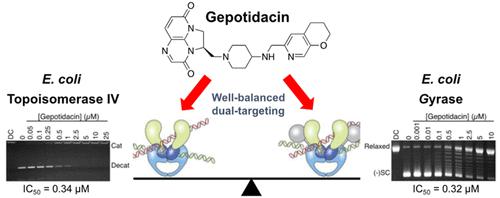当前位置:
X-MOL 学术
›
ACS Infect. Dis.
›
论文详情
Our official English website, www.x-mol.net, welcomes your feedback! (Note: you will need to create a separate account there.)
Interactions between Gepotidacin and Escherichia coli Gyrase and Topoisomerase IV: Genetic and Biochemical Evidence for Well-Balanced Dual-Targeting
ACS Infectious Diseases ( IF 5.3 ) Pub Date : 2024-03-05 , DOI: 10.1021/acsinfecdis.3c00346 Alexandria A. Oviatt 1 , Elizabeth G. Gibson 1, 2 , Jianzhong Huang 3 , Karen Mattern 3 , Keir C. Neuman 4 , Pan F. Chan 3 , Neil Osheroff 1, 5, 6
ACS Infectious Diseases ( IF 5.3 ) Pub Date : 2024-03-05 , DOI: 10.1021/acsinfecdis.3c00346 Alexandria A. Oviatt 1 , Elizabeth G. Gibson 1, 2 , Jianzhong Huang 3 , Karen Mattern 3 , Keir C. Neuman 4 , Pan F. Chan 3 , Neil Osheroff 1, 5, 6
Affiliation

|
Antimicrobial resistance is a global threat to human health. Therefore, efforts have been made to develop new antibacterial agents that address this critical medical issue. Gepotidacin is a novel, bactericidal, first-in-class triazaacenaphthylene antibacterial in clinical development. Recently, phase III clinical trials for gepotidacin treatment of uncomplicated urinary tract infections caused by uropathogens, including Escherichia coli, were stopped for demonstrated efficacy. Because of the clinical promise of gepotidacin, it is important to understand how the compound interacts with its cellular targets, gyrase and topoisomerase IV, from E. coli. Consequently, we determined how gyrase and topoisomerase IV mutations in amino acid residues that are involved in gepotidacin interactions affect the susceptibility of E. coli cells to the compound and characterized the effects of gepotidacin on the activities of purified wild-type and mutant gyrase and topoisomerase IV. Gepotidacin displayed well-balanced dual-targeting of gyrase and topoisomerase IV in E. coli cells, which was reflected in a similar inhibition of the catalytic activities of these enzymes by the compound. Gepotidacin induced gyrase/topoisomerase IV-mediated single-stranded, but not double-stranded, DNA breaks. Mutations in GyrA and ParC amino acid residues that interact with gepotidacin altered the activity of the compound against the enzymes and, when present in both gyrase and topoisomerase IV, reduced the antibacterial activity of gepotidacin against this mutant strain. Our studies provide insights regarding the well-balanced dual-targeting of gyrase and topoisomerase IV by gepotidacin in E. coli.
中文翻译:

Gepotidacin 与大肠杆菌旋转酶和拓扑异构酶 IV 之间的相互作用:平衡双靶向的遗传和生化证据
抗生素耐药性是对人类健康的全球性威胁。因此,人们正在努力开发新的抗菌剂来解决这一关键的医学问题。 Gepotidacin 是一种新型杀菌剂,是临床开发中的一流三氮杂苊类抗菌药。最近,吉泊达星治疗由尿路病原体(包括大肠杆菌)引起的单纯性尿路感染的 III 期临床试验因证实疗效而被停止。由于gepotidacin 的临床前景,了解该化合物如何与其细胞靶标、大肠杆菌的旋转酶和拓扑异构酶 IV 相互作用非常重要。因此,我们确定了参与gepotidacin相互作用的氨基酸残基中的旋转酶和拓扑异构酶IV突变如何影响大肠杆菌细胞对该化合物的敏感性,并表征了gepotidacin对纯化的野生型和突变型旋转酶和拓扑异构酶活性的影响四. Gepotidacin 在大肠杆菌细胞中对旋转酶和拓扑异构酶 IV 表现出平衡的双重靶向作用,这反映在该化合物对这些酶的催化活性的类似抑制作用上。 Gepotidacin 诱导旋转酶/拓扑异构酶 IV 介导的单链 DNA 断裂,但不诱导双链 DNA 断裂。与gepotidacin相互作用的GyrA和ParC氨基酸残基的突变改变了该化合物针对酶的活性,并且当同时存在于旋转酶和拓扑异构酶IV中时,降低了gepotidacin针对该突变菌株的抗菌活性。我们的研究提供了关于gepotidacin在大肠杆菌中平衡地双重靶向旋转酶和拓扑异构酶IV的见解。
更新日期:2024-03-05
中文翻译:

Gepotidacin 与大肠杆菌旋转酶和拓扑异构酶 IV 之间的相互作用:平衡双靶向的遗传和生化证据
抗生素耐药性是对人类健康的全球性威胁。因此,人们正在努力开发新的抗菌剂来解决这一关键的医学问题。 Gepotidacin 是一种新型杀菌剂,是临床开发中的一流三氮杂苊类抗菌药。最近,吉泊达星治疗由尿路病原体(包括大肠杆菌)引起的单纯性尿路感染的 III 期临床试验因证实疗效而被停止。由于gepotidacin 的临床前景,了解该化合物如何与其细胞靶标、大肠杆菌的旋转酶和拓扑异构酶 IV 相互作用非常重要。因此,我们确定了参与gepotidacin相互作用的氨基酸残基中的旋转酶和拓扑异构酶IV突变如何影响大肠杆菌细胞对该化合物的敏感性,并表征了gepotidacin对纯化的野生型和突变型旋转酶和拓扑异构酶活性的影响四. Gepotidacin 在大肠杆菌细胞中对旋转酶和拓扑异构酶 IV 表现出平衡的双重靶向作用,这反映在该化合物对这些酶的催化活性的类似抑制作用上。 Gepotidacin 诱导旋转酶/拓扑异构酶 IV 介导的单链 DNA 断裂,但不诱导双链 DNA 断裂。与gepotidacin相互作用的GyrA和ParC氨基酸残基的突变改变了该化合物针对酶的活性,并且当同时存在于旋转酶和拓扑异构酶IV中时,降低了gepotidacin针对该突变菌株的抗菌活性。我们的研究提供了关于gepotidacin在大肠杆菌中平衡地双重靶向旋转酶和拓扑异构酶IV的见解。






























 京公网安备 11010802027423号
京公网安备 11010802027423号